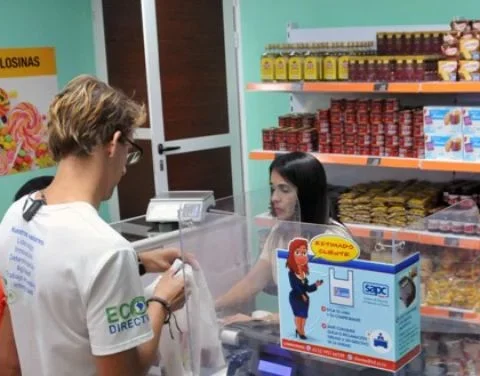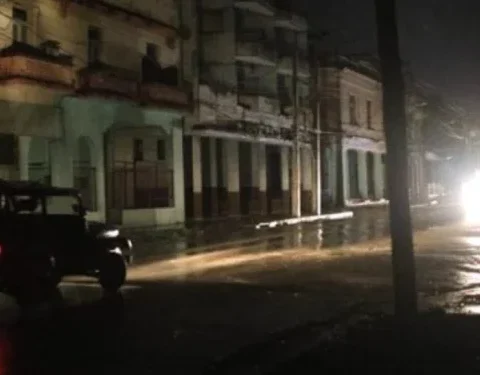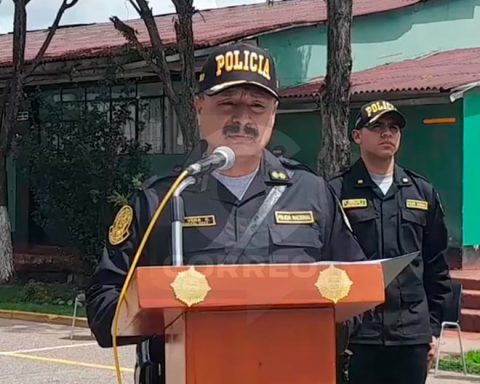SANTA CLARA, Cuba. – In February of last year, Yasmani and her nine-year-old son set out for Nicaragua to make the entire journey to the Mexican border and wait there patiently for permission to enter USA In the only backpack he took with him on the journey he decided to carry all the foundation stones he received when he “became a saint,” more than 30, including one in particular that weighed about three pounds.
Before boarding the plane in Cuba he had to “scrub them” so that they would remove any trace of blood. “I had been warned that they throw them away at the airport if they have blood on them. It happened to a friend, but they let me through without any problems, including my passport and all my necklaces,” says the young man who today shares his work as a cook with that of a drummer in religious ceremonies in Cuba. Miami and New York.
The departure of thousands of Cubans in the 80s and then in the hard years of the so-called Special Period towards the United States conditioned that the Regla de Osha, a religion of Afro-Cuban origin, popularly known as Santeria, took root so strongly in South Florida and that, to this day, with the increase in migration, it persists as one of the beliefs with a significant number of practitioners on that “other shore.”
According to what he points out a report by BBC Regarding Santeria in the United States, it is difficult to estimate the exact number of “faithful” due to the private nature of its ceremonies, although the “Santero hierarchs” themselves in Miami assure that they have data on the existence of communities especially in Philadelphia, New York, Los Angeles, Texas and New Jersey.
“The immigration officers at the border didn’t even touch my things, they put them aside and gave them back to me,” says Oscar Medero, a Cuban living in Orlando“Other people have not been so lucky, I suppose because they bring something that is forbidden, but I think that here I feel that there is a lot of acceptance on the part of Americans regarding the Yoruba religion.”
One particular event that occurred in the early 1990s set an important precedent for the practices of the Regla de Ocha-Ifá in Miami-Dade County. In 1993, the Lukumí Babalú Ayé Church of Hialeah won a legal battle against the city government, which until then had prohibited the sacrifice of animals as part of religious rituals. Protected by the First Amendment of the Constitution, this group of priests managed to be recognized as an institution by the Supreme Court of the United States.
Even so, many devotees of Afro-Cuban religions in exile have had to get used to a context different from that of Cuba and abide by civic norms and state laws that limit certain types of customs that are completely normal on the island.
“Here, almost everything that is done there is prohibited,” says Yasmani, based on his experience after more than a year living in Miami. “You cannot build construction sites in rivers, or in the sea, or in four corners, and even less in parks, cemeteries or in a police station. There are cameras everywhere. People manage in one way or another to make way for their own projects.” ebbóbut if you are caught in the act, you are faced with a fine of thousands of dollars.”
Another drummer, Noriel, adds that, to perform these drum beats in condominiums, for example, “you have to ask permission from the person in charge and you can’t bother the neighbors until the time you want. They are not as explosive as in Cuba and everyone has their own way of doing it.” team”.
On Afro-Cuban religious practices in Florida, anthropologist Jesús Fernández Cano throws in his doctoral thesis that Cubans have historically relived “traumatic situations” and that Osha is a point of reference in immigration that takes them back to a country and a culture from which they feel deprived. At the same time, the author indicates, it is also a mechanism to overcome their problems and difficulties in a foreign context such as exile.


“I arrived when I was iyawothat is, newly consecrated, and I have not yet finished my year,” she tells CubaNet A young Cuban woman who asks to be introduced by her saintly name, Omí Ladde. “I got a job selling juice in a juice shop, but when the owner saw me dressed in white and wearing so many necklaces, he sent me to the back to cut the fruit, so I wouldn’t interact with the customers. There are still those who see this religion as something demonic.”
Santeria practitioners, based mainly in South Florida, also face friction with official institutions and social prejudices due to some bad practices that have been made public in the media. Some time ago, two residents of Hialeah were arrested for “throwing dead chickens” on the beach of Virginia Key. Both of them justified themselves before the county police. claiming who were exercising their right to religious freedom.
The iyawo The interviewee points out that in Miami, as in Cuba, there is a lot of business with religion, cheating, clans and scams to people who are not fully informed. “As there, here they charge a lot for consultations, they sell everything that is needed for a saint and there are even those who make a living renting spaces for ceremonies.”
From Cuba to Miami and vice versa
In the 1970s and 1980s in Cuba, Afro-Cuban religions were practiced in ostracism in small houses and temples. According to the study “Obstacles faced by leaders and members of Afro-Cuban religions”It was not until the visit of the Nigerian priest Ooni of Ife to the island in 1987 and the imminent crisis of the 1990s that Santeria “established itself within the cultural heritage, even though it had previously been a cause of marginalization.” It even “became a sort of ally of power.”
Following the economic reforms that encouraged self-employment, religious articles stores proliferated on the island. These stores are mostly supplied by similar establishments in Miami and are known there as “botánicas.” Misael is a Cuban-American who travels frequently from Miami and who supplies one of these establishments in Santa Clara with certain merchandise that would be impossible to find for sale in Cuba in any state store.

“You could say that Miami and Cuba are also united by religion,” he says. He also confirms that most of the beads for necklaces and bracelets are made of ideasfabrics, incense or aromatic oils are brought from Florida, but there are other “items” that are taken from Cuba to the aforementioned “botanical gardens” or by special request from a Santero friend.
“There are people who have managed to get little things in [a Estados Unidos] “There are things that are really prohibited, like some seeds, soil and other things that I’d rather not specify,” he says. In this regard, the U.S. Customs and Border Protection Office (CBP) prohibits the entry into the territory of any part or product derived from animals such as skins, tusks, bones, feathers, as well as plants, cuttings and seeds that can reproduce.
In both Cuba and Florida, the celebration of a saint’s birthday or the so-called “güiros” constitute a major event for religious houses. The economic possibilities of those who reside in the United States contribute to the payment of many ceremonies on the Island that have gained in display of paraphernalia and glamour in recent years, in the image and likeness of those usually organized abroad. “Here in Miami, the “güiros” is already used catering and renting spaces with swimming pools and large patios, always in less elitist areas,” confirms Misael. “I have also seen this in Cuba. There are godchildren who give this pleasure to their godparents, as a thank you and because they are at an economic advantage.”


Many ceremonies in the US, including drums, bembés and wemileres They have a more discreet character compared to the Cuban custom of gathering crowds. “Here the drums are finer, some look like 15th birthday parties [años]. However, there are more private events, by invitation, and they are almost always held on weekends. This is not the Cuban neighborhood where everyone who comes, whether religious or not, joins out of curiosity or to eat at the end,” Yasmani adds. He also details that the rate for drummers ranges between 700 and 800 dollars.
Fernández Cano’s research shows that the glamorous saint’s celebrations in Florida also stem from the desire of the santeros to show their wealth or the success achieved as migrants. However, his field study detected the presence of some religious people who are in a less favorable situation, not having jobs or driving licenses, and who take advantage of the drums as one of the few occasions to socialize, eat in abundance, or take home some of what is distributed there, as also often happens in Cuba.
For the newly arrived Cubans, keeping their orishas “well cared for” and entertained also represents gratitude for offering them a better life, as Oscar explains: “I paid a lot of money to send for my battery of saints. If I didn’t want to be there, how could I leave them behind who opened the way for me to leave Cuba? My saints are also migrants without a return ticket.”
Follow our channel WhatsApp. Receive the information from CubaNet on your cell phone through Telegram.















